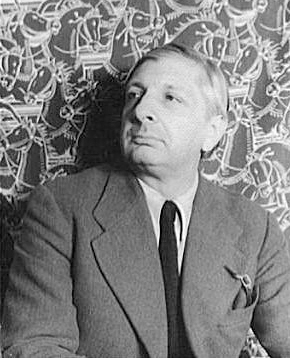
Giuseppe Maria Alberto Giorgio de Chirico was an Italian artist and writer born in Greece. In the years before World War I, he founded the scuola metafisica art movement, which profoundly influenced the surrealists. His best-known works often feature Roman arcades, long shadows, mannequins, trains, and illogical perspective. His imagery reflects his affinity for the philosophy of Arthur Schopenhauer and of Friedrich Nietzsche, and for the mythology of his birthplace.
Post-expressionism is a term coined by the German art critic Franz Roh to describe a variety of movements in the post-war art world which were influenced by expressionism but defined themselves through rejecting its aesthetic. Roh first used the term in an essay in 1925, "Magic Realism: Post-Expressionism", to contrast to Gustav Friedrich Hartlaub's "New Objectivity", which more narrowly characterized these developments within German art. Though Roh saw "post-expressionism" and "magic realism" as synonymous, later critics characterized distinctions between magic realism and other artists initially identified by Hartlaub and have also pointed out other artists in Europe who had different stylistic tendencies but were working within the same trend.

Carlo Carrà was an Italian painter and a leading figure of the Futurist movement that flourished in Italy during the beginning of the 20th century. In addition to his many paintings, he wrote a number of books concerning art. He taught for many years in the city of Milan.

Metaphysical painting or metaphysical art was a style of painting developed by the Italian artists Giorgio de Chirico and Carlo Carrà. The movement began in 1910 with de Chirico, whose dreamlike works with sharp contrasts of light and shadow often had a vaguely threatening, mysterious quality, "painting that which cannot be seen". De Chirico, his younger brother Alberto Savinio, and Carrà formally established the school and its principles in 1917.

The Song of Love is a 1914 painting by Italian metaphysical painter Giorgio de Chirico. It is one of the most famous works by Chirico and an early example of his pre-surrealist style, though it was painted ten years before the movement was "founded" by André Breton in 1924.

Alberto Savinio, born as Andrea Francesco Alberto de Chirico was a Greek-Italian writer, painter, musician, journalist, essayist, playwright, set designer and composer. He was the younger brother of 'metaphysical' painter Giorgio de Chirico. His work often dealt with philosophical and psychological themes, and he was also heavily concerned with the philosophy of art.
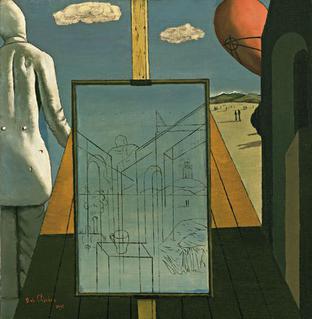
The Double Dream of Spring is a painting by the Italian metaphysical painter Giorgio de Chirico. It is held at the Museum of Modern Art, in New York.

The Melancholy of Departure is an oil on canvas painting by the Italian metaphysical painter Giorgio de Chirico, from 1916. This painting was created after Chirico returned to Italy from Paris to join the Italian Army in World War I. It is held at the Tate Modern, in London.

Metaphysical Interior with Biscuits is a 1916 painting by Italian metaphysical painter Giorgio de Chirico. It is one of the earliest editions in a series of works that extended late into Chirico's career.
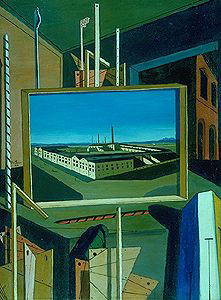
Metaphysical Interior with Large Factory is an oil-on-canvas painting by the Italian metaphysical painter Giorgio de Chirico, from 1916. It is part of a series that extended late into de Chirico's career.

Giorgio Morandi was an Italian painter and printmaker widely known for his subtly muted still-life paintings of ceramic vessels, flowers, and landscapes—their quiet, meditative quality reflecting the artist's rejection of the tumult of modern life.

The Enigma of the Hour is an oil on canvas painting by the Italian metaphysical painter Giorgio de Chirico. He created the work during his early period, in Florence, when he focused on metaphysical depictions of town squares and other urban environments. It is not clear whether it was created in 1910 or 1911.
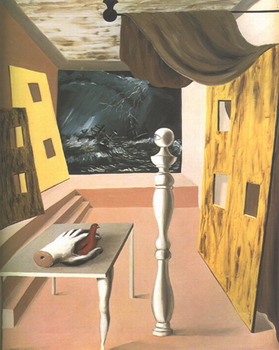
The Difficult Crossing(La traversée difficile) is the name given to two oil-on-canvas paintings by the Belgian surrealist René Magritte. The original version was completed in 1926 during Magritte's early prolific years of surrealism and is currently held in a private collection. A later version was completed in 1963 and is also held in a private collection.

Armando Spadini was an Italian painter and one of the representatives of the so-called Scuola Romana.
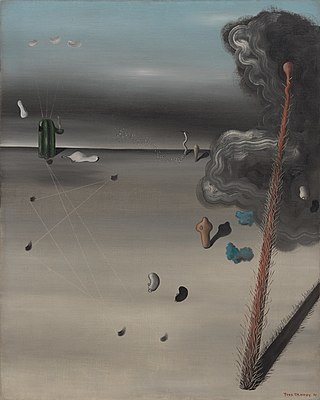
Mama, Papa is Wounded! is a 1927 oil-on-canvas painting by French surrealist painter Yves Tanguy.

Lady with a her Dressing Table is a painting by the French artist Jean Metzinger. This distilled synthetic form of Cubism exemplifies Metzinger's continued interest, in 1916, towards less surface activity, with a strong emphasis on larger, flatter, overlapping abstract planes. The manifest primacy of the underlying geometric configuration, rooted in the abstract, controls nearly every element of the composition. The role of color remains primordial, but is now restrained within sharp delineated boundaries in comparison with several earlier works. The work of Juan Gris from the summer of 1916 to late 1918 bears much in common with that of Metzinger's late 1915 – early 1916 paintings.

The Great Tower is an oil on canvas painting by the Italian artist Giorgio de Chirico, from 1921. It is held in the Pushkin Museum, in Moscow. The Russian Ministry of Culture acquired it in 1992 for the National Centre for Contemporary Arts, though the latter then transferred it to the Pushkin Museum in honour of its eightieth anniversary.

Château en Espagne is a painting made by the Dutchman Carel Willink in 1939. It depicts dark clouds over a landscape with a ruined villa and a statue of Apollo. It was influenced by the works by Giorgio de Chirico and has been interpreted as a comment to the Spanish Civil War. It is in the collection of Museum Arnhem in Arnhem, the Netherlands. Ferdinand Bordewijk used the painting as the basis for a prose poem published in 1940.
“The Disquieting Muses” is a poem by Sylvia Plath first appearing in the 1960 collection The Colossus and Other Poems published by William Heinemann, Ltd.
Mystery and Melancholy of a Street is an oil-on-canvas painting by the Italian artist Giorgio de Chirico, created in 1914. It is held in a private collection.

















